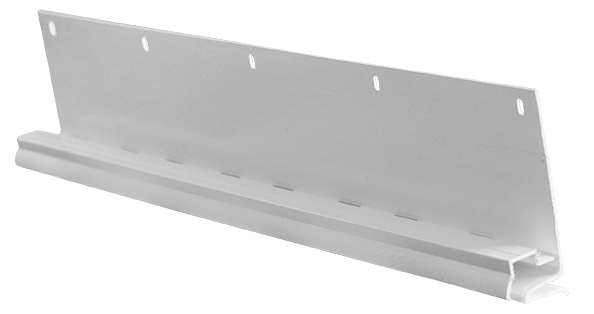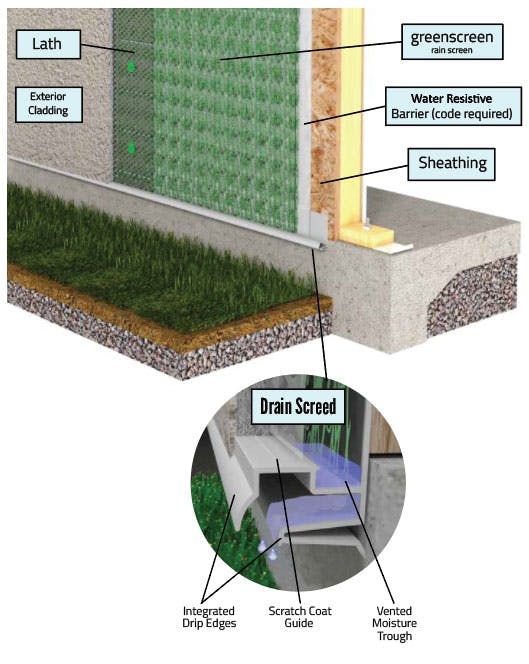
Stucco, brick & stone veneer, and siding all need to have a drainage system in place to allow moisture to escape from behind the wall’s exterior surface. These drainage systems prevent the buildup of moisture, which left unchecked can damage every part of the wall from the exterior surface to the internal structure within. Discoloration, foul smells, mold, mildew, rot, and more can all result from improper moisture drainage. Weep screeds are the most common wall drainage system and are used across the country in different environments. In most regions, screeds are mandatory for all new stucco walls due to how drastically they can extend the life of the stucco.
What is a Weep Screed?

Weep screeds are pieces of metal flashing specifically designed to be used at the bottom of a wall. They have holes that allow condensation to flow out through the bottom of the wall rather than remaining within it to cause serious damage. But, weep screeds aren’t only beneficial because they allow moisture to exit from the wall system. They also help by allowing air into the wall, speeding up the drying process. Without a screed, the space within your walls will get musty, which isn’t something you want to be said about your home.
Stucco is a porous exterior material, which means it allows moisture to seep into the walls naturally. That may sound like a negative quality, however, this also makes the wall more breathable. A more breathable wall is a good thing whenever it’s not raining. But, when there’s excess moisture that gets trapped between the walls, that’s when a weep screed is necessary. And the proper installation of a weep screed can make stucco one of the most durable building materials around by eliminating or drastically reducing its main weakness.
Basic Weep Screed Installation
When properly installed a weep screed should terminate walls below the top of the concrete foundation of the home. This ensures that any dripping water coming out of the screed’s holes will either end up on the ground or on the concrete foundation. Concrete foundations are much more resistant to moisture damage than other parts of the wall. Even slow dripping onto the more vulnerable parts of a wall can lead to serious damage over time.
There should also be at least 4 inches between the bottom of the screed and the ground. If there is paving that comes right up to the foundation of the home, a 2-inch minimum gap is required. These space requirements are in place to allow ample room for water to escape and flow away from the wall. If paving is added after the screed is installed, you will want to make sure the 2-inch gap to the screed is left intact. The same applies to any mulch or bushes that are placed against the house. They can block the screed holes, preventing water from escaping.
Drain Screed: A Superior Weep Screed

Traditional weep screeds come in two varieties. There are the #7 screeds and the J-type screeds. #7 screeds are the more common of the two because they have an angled surface that better drains excess moisture from the wall. However, the stucco installation also sits on top of this angled surface, which can cause issues. Specifically, the weight of the stucco can cause the lower portion of the wall to flare out and break. J-Type screeds don’t have this breakage issue, but they’re not as effective at draining and may leave some moisture behind.
The Drain Screed is an improved weep screed invented by Denis Friel. It combines the best aspects of the #7 and J-Type screeds without any of their drawbacks. For example, while the Drain Screed has an angled surface to drain moisture effectively, this lies below a horizontal shelf on which the stucco or other siding material sits. This horizontal shelf prevents the lateral stresses from being applied to the stucco and causing breakage.
Additional features of the Drain Screed include a 13mm trough to accommodate various thicknesses of rain screen and drainage mats and integrated drip edges designed to divert the flow of water away from the surface of the wall. These improvements over traditional weep screeds mean more water can escape from within your walls.
EZ VENT Evaporation Outlet
The EZ VENT part of the AMICO HYDRODRY® moisture control system along with the Drain Screed. It’s an evaporation outlet that gets installed at the top of the wall. While the Drain Screed allows condensed moisture to flow out from the bottom of the wall, the EZ VENT allows water vapor to escape out at the top. Combined, the Drain Screed and EZ VENT also create a two-way channel through which air can pass within the wall system, helping to dry everything out.
Prevent Moisture Buildup
While the best way to prevent moisture buildup is to prevent moisture from entering the wall in the first place, that’s generally not possible when siding materials and veneers are used. For this reason, a moisture control system is necessary. A basic weep screed may be able to get the job done, but the Drain Screed and EZ VENT of the AMICO HYDRODRY® system are a superior option. Since you can’t stop moisture from entering your walls, it’s important to have effective measures in place for allowing that moisture to escape.
Friel Exteriors
Are you in need of a new stucco installation or remediation? The improper installation of stucco or moisture control systems can cause serious damage to your home. This is why it’s so important to hire an experienced stucco and siding contractor. At Friel Exteriors, we have decades of experience with all kinds of siding materials. And as the creator of the Drain Screed, Denis Friel understands the importance of proper moisture control. Contact us today to schedule a quote inspection.




